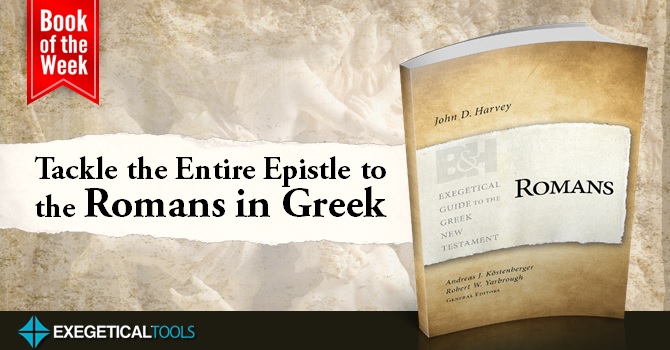So, you’ve been waiting for the Romans volume in the Exegetical Guides to the Greek New Testament series? We have too! And it’s finally here. 400 beautiful pages of analysis of Romans in Greek.
The Author
John D. Harvey has taught NT for decades and is now Dean of the Seminary and School of Ministry at Columbia International University. His other publications include Interpreting the Pauline Letters, Anointed with the Spirit and Power: A Biblical Theology of Holy Spirit Empowerment, Greek is Good Grief, Listening to the Text. Oral Patterning in Paul’s Letters. As these works suggest, Harvey is well-situated to write a guide to the Greek of one of Paul’s letters.
The Content
The EGGNTs include brief introductory information, since positions could affect one’s exegesis. Harvey takes Romans as written most likely from Corinth around AD 57. It was written to a mixed congregation of Jews and Gentiles, the latter in the majority, for a “cluster of purposes that address missionary, theological, and pastoral concerns.”
Harvey divides Romans into four main sections in the body (1:18-4:25; 5:1-8:39; 9:1-11:36; 12:1-15:13). He then explains each section including its structure, its Greek phrases, and recommended resources for continued study. I will note that the recommended resources can get lengthy, which is unusual for the EGGNT volumes, but a nice feature. For example, on Rom 8:29, Harvey lists about twenty-five works just on the topic of predestination and election, and the sources come from authors as diverse as Norman Geisler, D. A. Carson, and Paul Jewett.
The structure section is useful since it provides a block diagram for each section. I personally wish they were discourse analysis diagrams, but if they were, I doubt many would be able to read them since there are so many different methods of discourse analysis and diagramming.
Harvey also includes text-critical comments throughout the volume, although not in a manner near as consistent as your GNT’s apparatus or Metger’s Textual Commentary.
The Usefulness
This volume will help anyone who wants to improve their Greek or work through the Greek of Romans systematically, or for selected passages. Note that this is not a commentary on the meaning of the text, but rather an explanation of the most likely way to understand the syntax and the meaning of lexemes in context. But this task is the first in the exegetical process. You can’t understand what the text means until you know what it says.
If you will be teaching through Romans, Harvey will be a sure guide to the Greek text. If you want to study Romans on your own and use Harvey as a secondary source to check your own Greek work, he will guide you just as well.
One of the drawbacks to these volumes is their focus on the clause as opposed to large discourse structures such as paragraphs, sections, divisions, etc. The BHGNT series pays a bit more attention to wider discourse concerns, but those volumes also tend to be quite brief on syntax discussions, often just assuming one position. The EGGNT, by contrast, positively spends much more time on individuals clauses and words. Thus, the focus on the clause is both a strength and a weakness, but that weakness can be compensated for by one’s own wider reading of Romans and by using other resources such as the BHGNT series (although their Romans volume is not prepared yet).
Preview or buy it on Amazon.


